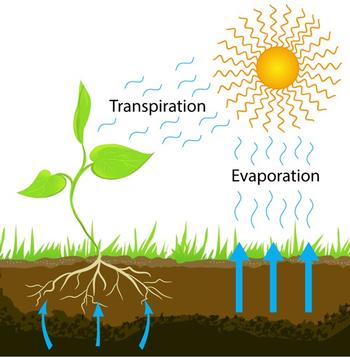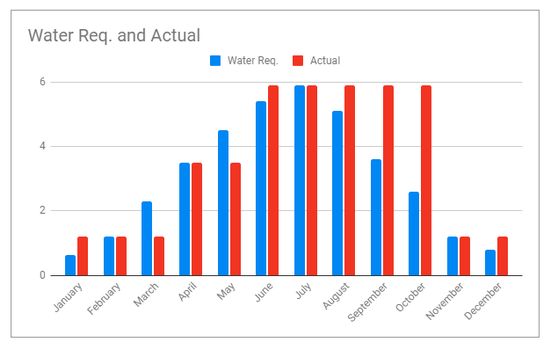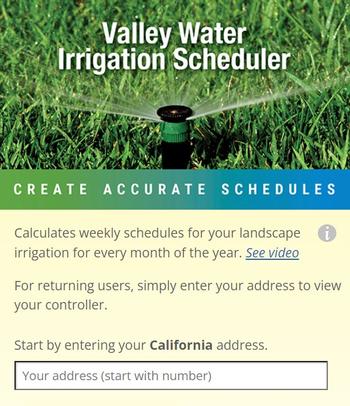Fall 2023
Try These Strategies to Use Less and Store More Water
by Lori Palmquist
It’s September, and the leaves are turning color, detaching, and floating to the Earth to form a mantle that feeds and shelters the soil and the resident soil organisms.
It’s Best to Ramp Back Watering August-December
Nature is signaling to us that it’s time to ramp back on our irrigation schedules. Although we may be experiencing 100 degree days, the amount of water the plants require is diminishing day by day. As we edge further away from the summer solstice and creep toward the winter one, the days are shorter and shorter. So, how does this relate to ramping back on our schedules?
How about a little Irrigation Scheduling 101? Consider the following graphic. Basic irrigation scheduling starts with a soil container full of water. The soil container is that area which is as deep as the deepest roots in the irrigation zone. In the graphic below, the brown areas would be saturated completely to begin the cycle. The blue squiggly lines in the air represent the water leaving the soil over days by evaporating from the top couple of inches of the soil and transpiring from the leaves of the plants. When enough water leaves the soil that there isn’t quite enough for the plants any more, we need to replace the water that has left by running the irrigation.

But how do we know how much water has left the soil, and thus needs to be replaced? California has a network of weather stations positioned throughout the state that reports hourly weather data to a central website. The site then crunches that data and provides water managers with the information that informs their irrigation schedules. I won’t burden you with the details. Just be assured that there are resources available that make it simple for you to create water-wise irrigation schedules that reflect the time of year correctly. And I’ll share those with you in just a little bit.
The main point I wish to convey is that from August through December, you should be adjusting your irrigation to deliver less water to the plants on a monthly basis, at a minimum. The weather factor that has the greatest influence over how much water is required by the plants is sunlight. After July, plant water needs drop significantly, regardless of the temperature.
Water Waste Due to Not Adjusting Monthly
A common scheduling practice is that people program in a schedule in July, and then leave it active all the way through October because it tends to be quite warm during that whole time. This practice wastes a lot of water. The graph below shows the water requirement in inches for each month of the year in blue for lawns in Walnut Creek. The red bars reflect actual water applied through common irrigation scheduling practices.
You can see that in August through October, there is significant water waste that happens due to this practice. For every 1,000 square feet of lawn, almost 4,000 gallons are wasted during those three months in Walnut Creek. For irrigation zones with moderate-water plants, almost 2,000 gallons would be wasted. For zones with low-water or native plants, 1,000 gallons would be wasted. And this would be for just one property. So you can see it’s very important to turn your irrigation down monthly between August and December. If it starts raining regularly, you should shut off the irrigation completely, no matter what month it is.

How to Create Accurate Watering Schedules
Fortunately for all of us in California, there is a new free web application available that creates accurate monthly irrigation schedules. It’s called the Valley Water Scheduler, and it comes to us from Valley Water District in San Jose (see screenshot below). You can access this tool at the following link: https://www.valleywaterscheduler.com/

This application uses your address to access the historical weather data for your region. It uses these data and information that you provide about your irrigation system, and it generates an accurate, monthly irrigation schedule for every irrigation zone on your property. You can download this schedule as a pdf and keep it next to the controller to keep you on track at all times. It will even save your information in case anything changes, and you need to adjust the schedule. And you don’t even have to create an account or log in. It saves the information based on your address. So, with a tool like this, there is really no reason not to have water-wise irrigation schedules.
How Does Mulch Lower Your Plants’ Water Needs?
Another very important practice for you to start now is to cover your landscape with a generous layer of mulch. Remember that I told you above that irrigation replaces water that has left the soil by way of evaporation and transpiration?
A study done at Texas A&M University found that just one inch of mulch spread over a planted area lowers the plant water requirement by 25%. This is because it covers the soil and inhibits water from being readily evaporated from the soil. This is big! It’s especially important because mulching your landscape also provides food for the soil organisms so that they can provide for healthy and robust soil and plants.
And those plentiful and robust soil organisms break down the mulch and incorporate it into the soil, making the soil into a sponge that holds onto more water! So everybody wins! It just doesn’t get any better than that!
The best mulch to use that is recommended for both firescaping and for stormwater handling is composted wood mulch. As the soil organisms break the mulch down, this enables your yard to better handle the abundant water when those atmospheric rivers flow through in the winter. So using a generous cover of mulch on your soil is great for both too much and too little water in times of drought and deluge. My recommendation is that you first look for composted wood mulch. If you can’t find that, the second choice is arbor chips from a local tree service. But do make sure that you use a non-flammable mulch within five feet of the house and other structures for fire safety.
So turn down the irrigation and cover up that soil! Both of these actions will prepare your landscape for whatever this fall and winter bring us. And they’ll go a long way toward assuring you get to enjoy your lovely garden well into the future.
